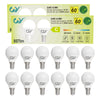
LED Light Color Explained: 3000K, 4000K or 5000K – Which Color Temperature Suits You
LED Light Color Explained: 3000K, 4000K or 5000K – Which Color Temperature Suits You?
When purchasing LED lamps, color temperature is a crucial factor – it influences not only the room atmosphere but also your wellbeing and productivity.
What Is Color Temperature (Kelvin)?
Color temperature describes the light color of a source and is measured in Kelvin (K):
- Warm White (2700K–3000K): Soft, yellowish light – similar to incandescent bulbs. Ideal for living rooms and bedrooms.
- Neutral White (3500K–4000K): Bright, balanced light – neutral but not cold. Perfect for kitchen, bathroom, and office.
- Cool White (5000K–6500K): Clear, bluish-white light – enhances focus. Suitable for workspaces, workshops, garages.
Why Is the Right Color Temperature Important?
- Wellbeing & Sleep: Warm light (2700K) promotes relaxation and healthy sleep. Cool light (5000K+) suppresses melatonin – good for waking up in the morning.
- Performance & Concentration: Cool white light improves alertness and visual clarity – ideal for offices or workbenches.
- Room Atmosphere: Different light colors create targeted moods – from cozy to functional.
Recommended Color Temperature by Room
| Room | Recommended Color Temperature | Purpose |
|---|---|---|
| Living Room | 2700K–3000K | Relaxing, cozy atmosphere |
| Bedroom | 2700K | Calming, sleep-promoting |
| Kitchen | 3500K–4000K | Clear visibility for safe tasks |
| Office / Study | 4000K–5000K | Focused work |
| Bathroom | 4000K | Neutral, clear lighting |
| Workshop / Garage | 5000K–6500K | Bright, functional illumination |
Tips for Using Light Colors in Daily Life
- Morning: 4000K–5000K – activating and concentration-promoting
- Evening: 3000K–3500K – relaxing and eye-friendly
- Night: Below 2700K – e.g., as a low-brightness night light
- Sensitive to light? Choose a warmer light color
- Vision issues? Neutral white (approx. 4000K–4500K) can help
Frequently Asked Questions
Is a higher Kelvin value automatically better?
No – it depends on the purpose. Warm white is ideal for relaxing, cool white for precise work.
How do I find the color temperature of a lamp?
Check the packaging or product description – the Kelvin value is always indicated (e.g., “3000K”).
Can I combine different color temperatures in the same room?
Only with a well-planned lighting concept. Too many different temperatures can feel chaotic.
Conclusion
Choosing the right color temperature is essential for comfort, health, and productivity. Whether cozy or efficient – the right LED lighting brings out the best in any room.










